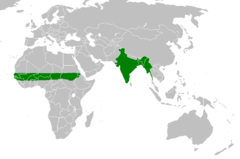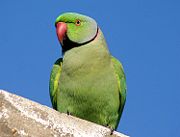Rose-ringed Parakeet
2008/9 Schools Wikipedia Selection. Related subjects: Birds
| Rose-ringed Parakeet | ||||||||||||||
|---|---|---|---|---|---|---|---|---|---|---|---|---|---|---|
 Female on left and male on right
|
||||||||||||||
| Conservation status | ||||||||||||||
|
Least Concern
|
||||||||||||||
| Scientific classification | ||||||||||||||
|
||||||||||||||
| Binomial name | ||||||||||||||
| Psittacula krameri ( Scopoli, 1769) |
||||||||||||||
 Original (wild) range
|
The Rose-ringed Parakeet (Psittacula krameri), also known as the Ringnecked Parakeet, is a gregarious tropical parakeet species that is popular as a pet. Its scientific name commemorates the Austrian naturalist Wilhelm Heinrich Kramer.
This non-migrating species is one of few parrot species that have successfully adapted to living in 'disturbed habitats', and in that way withstood the onslaught of urbanisation and deforestation. In the wild, this is a noisy species with an unmistakable squawking call.
As is the case with all Psittacula (Afro-Asian Ringnecked Parakeet) species, the Rose-ringed Parakeet is sexually dimorphic. The adult male sports a black neck-ring and pink nape-band while the hen and immature birds of both sexes either show no neck rings, or display shadow-like pale to dark grey neck-rings and light (lighter coloured than surroundings) nape-bands.
Phylogeny and distribution
Four subspecies are recognized, though they do not differ much:
- African subspecies:
(P. krameri krameri): African-ringnecked (aka ARN) Parakeet : West Africa in Guinea, Senegal and southern Mauretania, east to Western Uganda, Eastern South Africa, and Southern Sudan.
(P. krameri parvirostris): Abyssinian-ringnecked (aka Aby-RN) Parakeet : Northwest Somalia, west across northern Ethiopia to Sennar district, Sudan.
- Asian subspecies:
(P. krameri manillensis): Indian-ringnecked (aka IRN) Parakeet : Originates from the southern Indian subcontinent; and has feral and/or naturalized populations worldwide. In Australia, United States, and other western countries, it is often referred to as the Indian Ring-Necked Parakeet/Parrot.


'Vallbh Vidyanagar', a small town in Gujarat has thrving population of Rose-ringed Parakeet around 63,000. Vidyanagar Nature Club has safe guarded its habitat.
(P. krameri borealis): boreal or Neumann's ringnecked (aka BRN) Parakeet :Bangladesh, northern India and Nepal to central Burma; introduced populations worldwide in localities.
A phylogenetic analysis using DNA (see Psittacula) showed that the Mauritius Parakeet (Psittacula echo) is closely related to this species, and probably needs to be placed between the African and Asian subspecies. Consequently, this species is paraphyletic.
Diet
In the wild, Rose-ringed Parakeets usually feed on buds, fruits, vegetables, nuts, berries and seeds. Wild flocks also fly several miles to forage in farmlands and orchards causing extensive damage.
Size
Rose-ringed Parakeets measure on average 40 cm (16 inches) long including the tail feathers. Its average single wing length is about 15–17.5 cm (6-7 inches). The tail accounts for a large portion of their total length. African ssp. are slender in bodies but usually display longer tail feathers (more so in mature male specimens) than Asian ssp. which are typically stockier in bodies. The former usually display darker (brownish-red) upper mandibles while the latter always display bright-red upper-mandibles.
Feral Rose-ringed Parakeets
The Rose-ringed Parakeet has established feral populations in India, a number of European cities, South Africa and Japan. There are also apparently stable populations in the USA in Florida and California, and a small but self-sustaining population Tehran, Iran, mostly concentrated in the northern parts of city. They are also found almost throughout Israel.
The European populations became established during the mid to late 20th Century from introduced and escaped birds. There are two main population centres in Britain: the largest is based around south London, Surrey and Berkshire, and by 2005 consisted of many thousands of birds. A smaller population occurs around Margate, Broadstairs and Ramsgate, Kent. Elsewhere in Britain, smaller feral populations have established from time to time (e.g., at Studland, Dorset, Kensington Gardens, and South Manchester). It has been suggested that feral parrots could endanger populations of native British birds, and that the Rose-ringed Parakeet could even be culled as a result.
In the Netherlands and Belgium, there exist a network of feral populations numbering 5-6000 each in urbanized areas. In Germany, these birds are found along the Rhine in all major urban areas between Neuss/Düsseldorf and Heidelberg, and in the northeast of Hamburg. Other populations are found around Paris and in Barcelona.
The specimens in these naturalized populations often represent intra-specific hybrids, originally between varying numbers - according to locality - of the subspecies manillensis, borealis, and/or (to a lesser extent) krameri along with some inter-specific hybrids with naturalized Psittacula eupatria (Alexandrine Parakeet).
However, in some parts of South Asia - from where the Rose-ringed Parakeets originated, populations of these birds are decreasing due to trapping for the pet trade. Despite some people's attempts to revive their population by freeing these birds from local markets, the Rose-ringed Parakeet's population has dropped drastically in many areas of the Indian subcontinent.
Rose-ringed Parakeets as pets
These birds were first taken as pets by the people of India at least 3,000 years ago. Later, colour mutations of Indian-ringnecked parakeets were also bred. The royals prized them as pets and for their ability to talk. It was a popular status symbol in Indian culture to have an Indian-ringnecked (IRN) parakeet.
Back in the Hellenistic Era, Psittacula specimens (and most particularly P. cyanocephala, P. eupatria. P. k. borealis & P. k. manillensis) were the first Parrots brought to Europe by Alexander The Great's legionnaries. The Greeks were the first Europeans to breed them. Socrates is reported to have praised its beauty and ability to speak. The Romans then bred them for pets in their aviaries.
In the 1920s the popularity of the breed with aviculturists began to increase greatly. Now widely available in the pet trade, Rose-ringed Parakeets continue to gain popularity. Hand-fed Rose-ringed Parakeets are regarded as excellent pets if provided with daily attention, though even parent-raised Rose-ringed Parakeets make good pets when provided with regular handling and attention. They are generally family birds and are less likely to bond to only one person.
Rose-Ringed Parakeets are considered to be very intelligent and very independent. Young birds develop their independent side early in life and at a few months of age will begin to test their limits. This is known as the 'bluffing' stage, as they will suddenly become irritable and bite. When they are young some birds can become territorial of their cage. Young birds are better equipped to learn the basic skills, such as 'step up', 'step down', 'dead bird' and the towel. After sexual maturity, it is much harder to build this parrot-human bond.
They are highly intelligent birds and require a large amount of mental stimulation, such as toys that require them to logically solve a puzzle to receive a treat. This is especially important if they do not receive a large amount of human interaction.
They require a relatively tall cage because of their long tails. A Rose-ringed Parakeet who will be spending most of his/her day inside the cage should be kept in a cage about 60 cm (24") wide x 45 cm (18") deep x 90 cm (36") high, though the larger the better, and the bar spacing should be between 1.25 cm (1/2 inch) and 1.875 cm (3/4 inch). Rose-ringed Parakeets are avid chewers and climbers and should therefore be provided with chewing toys in their cages. The cages should be in a place out of direct sunlight and free of drafts. A pet or captive Rose-ringed Parakeet should be kept in a bird-safe environment.
Rose-ringed Parakeets & other Psittacula species require a basic staple diet of pellets, nuts and seeds of best qualities. With daily or so offerings of cooked &/or fresh healthy food items such as whole-grain cereals, edible blossoms/flowers, fruits (except only the avocado which is poisonous to parrots), Greens, well cooked legumes/pulses, legume/pulse's &/or seed sprouts, vegetables (except uncooked onions nor uncooked potatoes)... Every parrot should always have access to fresh water in their cages. A daily bath, mist or shower is required. Known for their eternally perfect feather condition, the moisture helps these vivacious birds preen and retain the pristine sheen of their feathers.
Now among P. krameri ssp. (Rose-ringnecked Parakeet sub-species) only the Indian-ringnecked (IRN) Parakeet sub-species evolved & thus is available in countless colour mutations from the Wildtype (natural Green colour; ADMpied (aka recessive-pied), Aqua, Blue, Bronzefallow, Cinnamon, Clearflighted, Clearheaded, Cleartailed, Darkfactor, Dominant Edged, Dominantpied, Dunfallow, Greyfactor, Ino, Misty (aka Khaki), Opaline, Pallid (erraneously known as 'LaceWings'), Pied, Recessive Edged, Slaty, Suffused (cka Dilute), Turquoise, Violet-Factored.
Just like all parrots individual birds have personalities different from one another and is never directly related to visual colour.

